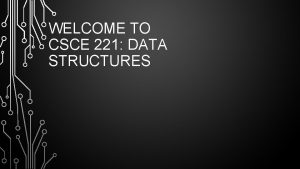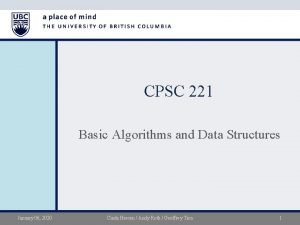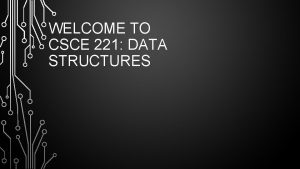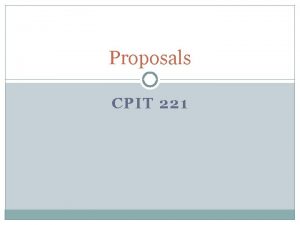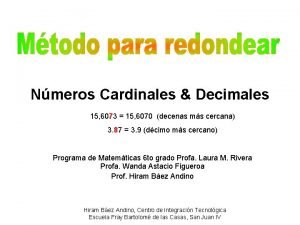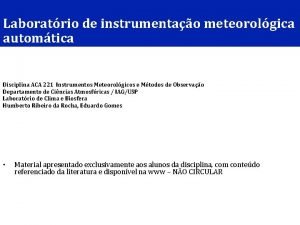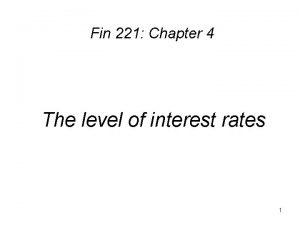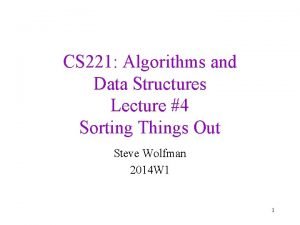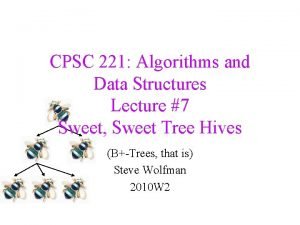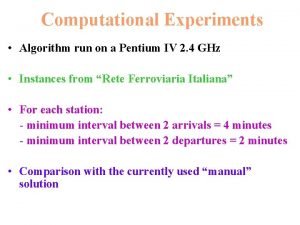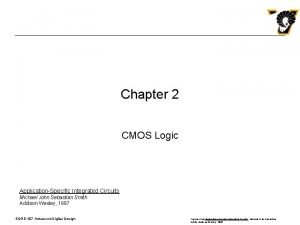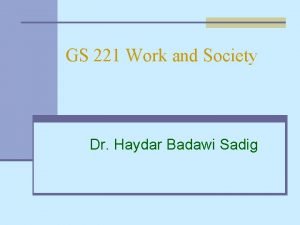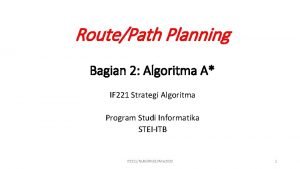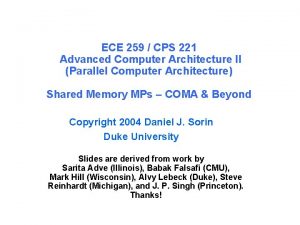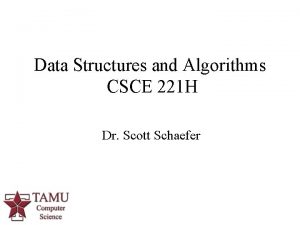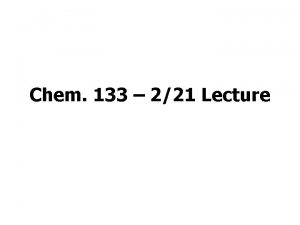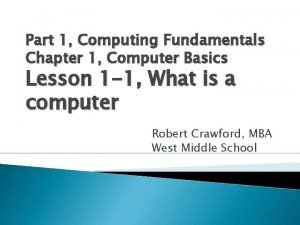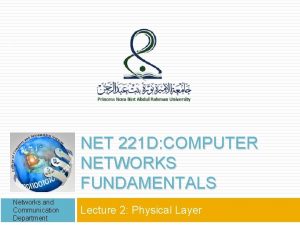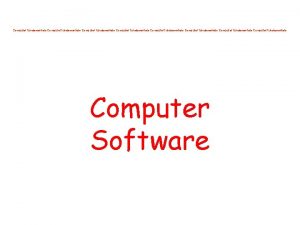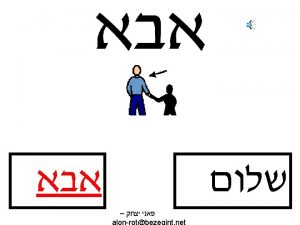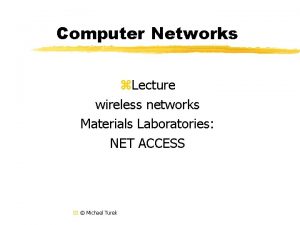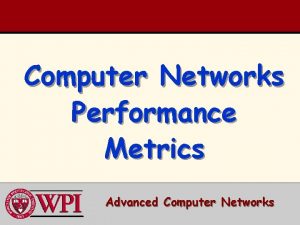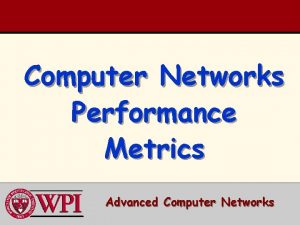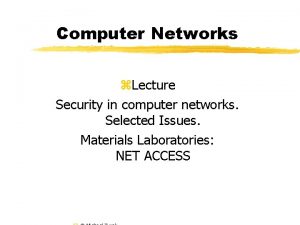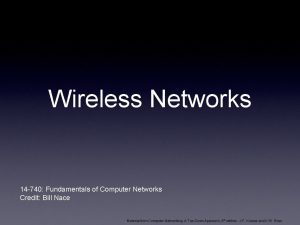1 NET 221 D COMPUTER NETWORKS FUNDAMENTALS Lecture

























































- Slides: 57

1 NET 221 D: COMPUTER NETWORKS FUNDAMENTALS Lecture 5: Network Layer

Introduction 2 Physical and data link layers operate locally; they know nothing about other layers, their task is limited to deliver data from one node to the next (immediate) node , through only one link and not beyond. The network layer is responsible for the source-todestination delivery of a packet, possibly across multiple networks (links). Network layer is responsible for host to host delivery and for routing the packets through the routers.

3

Cont. Introduction 4 The network layer adds a header that includes the logical addresses of the sender and receiver to the packet corning from the upper layer. If a packet travels through the Internet, we need this addressing system to help distinguish the source and destination. When independent networks or links are connected together to create an internetwork , routers or switches route packets to their final destination.

5 LOGICAL ADDRESSING

1 -Logical Addressing 6 q q q We use the term internet protocol (IP) address to mean a logical address in the network layer of the TCP/IP protocol. The Internet addresses are 32 bits in length; this gives us a maximum of 2^32 addresses. These addresses are referred to as IPv 4 (IP version 4) addresses. The need for more addresses, in addition to other concerns about the IP layer, motivated a new design of the IP layer called the new generation of IP or IPv 6 (l. P version 6). In this version, the Internet uses 128 -bit addresses that give much greater flexibility in address allocation. These addresses are referred to as IPv 6 (IP version 6) addresses.

7 Ø Ø Ø § An IPv 4 address is a 32 -bit address that uniquely and universally defines the connection of a device (for example, a computer or a router) to the Internet. Two devices in the Internet can never have the same address at the same time. An address may be assigned to a device for a time period and then taken away and assigned to another device. If a device operating at the network layer (e. g. router) has m connections to the Internet, it needs to have m IP address. IPV 4 has an address space: is the total number of addresses used by the protocol. If a protocol uses N bits to define an address, the address space is

8 There are two prevalent notations to show an IPv 4 address: binary notation and dotted decimal notation.

9 Binary-to decimal and decimal to binary

Example # 1 Change the following IPv 4 addresses from binary notation to dotted-decimal notation. Solution We replace each group of 8 bits with its equivalent decimal number (see Appendix B) and add dots for separation. 19. 10

Example # 2 Change the following IPv 4 addresses from dotted-decimal notation to binary notation. Solution We replace each decimal number with its binary equivalent (see Appendix B). 19. 11

Example # 3 Find the error, if any, in the following IPv 4 addresses. Solution a. There must be no leading zero (045). b. There can be no more than four numbers. c. Each number needs to be less than or equal to 255. d. A mixture of binary notation and dotted-decimal notation is not allowed. 19. 12

A. Classful addressing 19. 13 IPv 4 addressing used the concept of classes (classful addressin Note In classful addressing, the address space is divided into five classes: A, B, C, D, and E.

Figure 19. 2 Finding the classes in binary and dotted-decimal notation Example : Find the class of each address : a. b. c. d. 00000001011 11101111 110000011 00011011 1111 14. 23. 120. 8 252. 5. 111

Classes and Blocks 19. 15 One problem with classful addressing is that each class is divided into a fixed number of blocks with each block having a fixed size as shown in Table 19. 1 Number of blocks and block size in classful IPv 4 addressing In classful addressing, a large part of the available addresses were wasted.

Netid and Hostid 19. 16 In classful addressing, an IP address in class A, B, or C is divided into netid and hostid. These parts are of varying lengths, depending on the class of the address. Figure 19. 2 ( in previous slide) shows some netid and hostid bytes. The netid is in color, the hostid is in white. Note that the concept does not apply to classes D and E

Mask 17 Although the length of the netid and hostid (in bits) is predetermined in classful addressing, we can also use a mask (called the default mask). The masks for classes A, B, and C are shown in Table 19. 2. The mask can help us to find the netid and the hostid. For example, the mask for a class A address has eight 1 s, which means the first 8 bits of any address in class A define the netid; the next 24 bits define the hostid. The last column of Table 19. 2 shows the mask in the form /n where n can be 8, 16, or 24 in classful addressing. This notation is also called slash notation or Classless Interdomain Routing (CIDR) notation.

19. 18 B. Classless addressing. Note • Classful addressing, which is almost obsolete, is replaced with classless addressing. • In classless addressing, we can divide the address space into variable-length blocks. • There are three restrictions in classless addressing: a. The number of addresses needs to be a power of 2. b. The mask needs to be included in the address to define the block. c. The starting address must be divisible by the number of addresses in the block.

Example Figure 19. 3 shows a block of addresses, in both binary and dotted-decimal notation, granted to a small business that needs 16 addresses. We can see that the restrictions are applied to this block. The addresses are contiguous. The number of addresses is a power of 2 (16 = 24), and the first address is divisible by 16. The first address, when converted to a decimal number, is 3, 440, 387, 360, which when divided by 16 results in 215, 024, 210.

Mask 20

Example # 1 a. A block of addresses is granted to a small organization. We know that one of the addresses is 205. 16. 37. 39/28. What is the first address in the block? Solution The binary representation of the given address is 11001101 00010000 00100101 00100111 If we set 32− 28 rightmost bits to 0, we get 11001101 00010000 00100101 0010000 or 205. 16. 37. 32. This is actually the block shown in Figure 19. 3. 19. 21

Example cont. b. Find the last address for the block in Example 19. 6. Solution The binary representation of the given address is 11001101 00010000 00100101 00100111 If we set 32 − 28 rightmost bits to 1, we get 11001101 00010000 00100101111 or 205. 16. 37. 47 c. Find the number of addresses in Example 1. Solution The value of n is 28, which means that number of addresses is 2 32− 28 or 16.

Example # 2 Another way to find the first address, the last address, and the number of addresses is to represent the mask as a 32 -bit binary (or 8 -digit hexadecimal) number. This is particularly useful when we are writing a program to find these pieces of information. In Example 19. 5 the /28 can be represented as 11111111 11110000 (twenty-eight 1 s and four 0 s). Find a. The first address b. The last address c. The number of addresses. 19. 23

Example (continued) Solution a. The first address can be found by ANDing the given addresses with the mask. ANDing here is done bit by bit. The result of ANDing 2 bits is 1 if both bits are 1 s; the result is 0 otherwise. 19. 24

Example (continued) b. The last address can be found by ORing the given addresses with the complement of the mask. ORing here is done bit by bit. The result of ORing 2 bits is 0 if both bits are 0 s; the result is 1 otherwise. The complement of a number is found by changing each 1 to 0 and each 0 to 1. 19. 25

Example (continued) c. The number of addresses can be found by complementing the mask, interpreting it as a decimal number, and adding 1 to it. Note The first address in a block is normally not assigned to any device; it is used as the network address that represents the organization to the rest of the world.

Hierarchy 19. 27 An example of hierarchy is a telephone network that has three level of hierarchy Two-Level Hierarchy: No Subnetting An IP address can define only two levels of hierarchy when not subnetted. The n leftmost bits of the address x. y. z. t/n define the network (organization network); the 32 – n rightmost bits define the particular host (computer or router) to the network. The two common terms are prefix and suffix. The part of the address that defines the network is called the prefix; the part that defines the host is called the suffix. Figure 19. 6 two levels of hierarchy in an ipv 4 address

Three-Levels of Hierarchy: Subnetting An organization that is granted a large block of addresses may want to create clusters of networks (called subnets) and divide the addresses between the different subnets. As an example, suppose an organization is given the block 17. 12. 40. 0/26, which contains 64 addresses. The organization has three offices and needs to divide the addresses into three subblocks of 32, 16, and 16 addresses. We can find the new masks by using the following arguments: 1. Suppose the mask for the first subnet is n 1, then 2^(32 - n 1) must be 32, which means that n 1 =27. 2. Suppose the mask for the second subnet is n 2, then 2^(32 - n 2) must be 16, which means that n 2 = 28. 3. Suppose the mask for the third subnet is n 3, then 2^(32 - n 3) must be 16, which means that n 3 =28. This means that we have the masks 27, 28 with the organization mask being 26.

Three-Levels of Hierarchy: Subnetting Figure 19. 7 Configuration and addresses in a subnetted network

Configuration and addresses in a subnetted network 19. 30

31 • • The Internet Protocol version 4 (IPv 4) It is the current and common delivery mechanism used by the TCP/IP protocols. IPv 4 is an unreliable connectionless protocol responsible for source-to-destination delivery. Packets in IPv 4 layer are known as Datagram which consists of two parts: a header and data (payload). • The length of the header is 20 – 60 bytes and it contains essential information for routing and packet delivery. The position of IPv 4 in TCP/IP protocol suit and its datagram format are shown in Figure 20. 4 and 20. 5 respectively

32 The Internet Protocol version 4 (IPv 4) It is a layer 3 protocol � Host-to-host network layer delivery protocol for the internet. � It is unreliable and connectionless protocol. No error control. No flow control. It has error detection (discard) � If reliability is of concern, the IP has to be tied to a connection-oriented protocol (i. e. TCP) - In reality, each packet (datagram) is handled independently: - Each packet can follow different rout to destination. -Thus, Packets may arrive out of order, dropped and/or lost. IP relies on higher level protocols to take care of all these problems.

A datagram is a variable-length packet consisting of two parts: header and data. Figure 20. 5 IPv 4 datagram format

Internet Protocol (IPv 4): Header Format Field Length Description Version 4 bit Identifies the version of IP used to generate the datagram HLEN 4 bit Specifies the length of the IP header, including the length of any options and padding. The normal value of this field when no options are used is (20 bytes) value must be multiplied by 4 to give the length in bytes Service (TOS) 8 bit Type of Service (TOS): A field designed to carry information to provide quality of service features, such as prioritized delivery, for IP datagram. Total Length (TL) 16 bit Specifies the total length of the IP datagram, in bytes. Since this field is 16 bits, the maximum length of an IP datagram is 65, 535 bytes (2^16 – 1) of which 20 -60 byte is the header. Identification 16 bit This field is used by the receiver to reassemble messages without mixing fragments from different messages. Flags 3 bit Control flags to manage fragmentation Fragmentation offset 13 bit This field specifies the offset, or position, in the overall message where the data in this fragment goes. Time to live (TTL) 8 bits Specifies how long the datagram is allowed to “live” on the network, in terms of router hops. Each router decrements the value of the TTL by one prior to transmitting it. If the TTL =0, the datagram is 34 discarded.

Internet Protocol (IPv 4): Header Format Field Length Description Protocol 8 bit Identifies the higher layers protocols (transport or encapsulated network layer protocols) carried in the datagram Header checksum 16 A checksum computed over the header to provide basic protection against corruption in transmission Source address 32 bit The 32 -bit IP address of the originator of the datagram (intermediate device will not change it) Destination address 32 bit The 32 -bit IP address of the intended recipient of the datagram. (intermediate device will not change it) options One or more of several types of options may be included after the standard headers in certain IP datagram var Note The total length field defines the total length of the datagram including the header. Since the field length is 16 bits, the total length (header + data) is 65 515 bytes. 20 to 60 bytes are used as header. Thus, length of data = total length - header 35

Example An IPv 4 packet has arrived with the first 8 bits as shown: 01000010 The receiver discards the packet. Why? Solution There is an error in this packet. The 4 leftmost bits (0100) show the version, which is correct. The next 4 bits (0010) show an invalid header length (2 × 4 = 8). The minimum number of bytes in the header must be 20. The packet has been corrupted in transmission. 20. 36

Fragmentation 20. 37 Figure 20. 10 Flags used in fragmentation Figure 20. 11 Fragmentation example

Figure 20. 12 Detailed fragmentation example 20. 38

Example 20. 5 A packet has arrived with an M bit value of 0. Is this the first fragment, the last fragment, or a middle fragment? Do we know if the packet was fragmented? Solution If the M bit is 0, it means that there are no more fragments; the fragment is the last one. However, we cannot say if the original packet was fragmented or not. A non-fragmented packet is considered the last fragment. 20. 39

Examples 1. A packet has arrived with an M bit value of 1. Is this the first fragment, the last fragment, or a middle fragment? Do we know if the packet was fragmented? Solution If the M bit is 1, it means that there is at least one more fragment. This fragment can be the first one or a middle one, but not the last one. We don’t know if it is the first one or a middle one; we need more information (the value of the fragmentation offset). 2. A packet has arrived with an M bit value of 1 and a fragmentation offset value of 0. Is this the first fragment, the last fragment, or a middle fragment? Solution Because the M bit is 1, it is either the first fragment or a middle one. Because the offset value is 0, it is the first fragment.

3. A packet has arrived in which the offset value is 100. What is the number of the first byte? Do we know the number of the last byte? Solution To find the number of the first byte, we multiply the offset value by 8. This means that the first byte number is 800. We cannot determine the number of the last byte unless we know the length. 4. A packet has arrived in which the offset value is 100, the value of HLEN is 5, and the value of the total length field is 100. What are the numbers of the first byte and the last byte? Solution The first byte number is 100 × 8 = 800. The total length is 100 bytes, and the header length is 20 bytes (5 × 4), which means that there are 80 bytes in this datagram. If the first byte number is 800, the last byte number must be 879.

NETWORK ROUTING ALGORITHMS 42

2. Routing algorithm 43

Network Performance Measures 44 Two Performance Measures � Quantity of Service (Throughput) How much data travels across the net? How long does it take to transfer long files? � Quality of Service (Average packet delay) How long does it take for a packet to arrive at its destination? How responsive is the system to user commands? Can the network support real-time delivery such as audio and video?

The Optimality Principle 45 Each portion of a best path is also a best path; the union of them to a router is a tree called sink tree • Best path means a path with fewest hops as an example The set of optimal routes to a particular node forms a sink tree. Sink trees are not necessarily unique Goal of all routing algorithms: � Discover sink trees for all destinations - (with out loops)

a) Flooding 46 A simple method to send a packet to all network nodes Each node floods a new packet received on an incoming link by sending it out all of the other links Nodes need to keep track of flooded packets to stop the flood; even using a hop limit can blow up exponentially

b. Shortest Path Routing (a nonadaptive routing algorithm) 47 Shortest path algorithm first developed by E. W. Dijkstra Given a network topology and a set of weights describing the cost to send data across each link in the network Find the shortest path from a specified source to all other destinations in the network.

Cont. 48 Steps : 1. Mark the source node as permanent. 2. Designate the source node as the working node. 3. Set the tentative distance to all other nodes to infinity. 4. While some nodes are not marked permanent Compute the tentative distance from the source to all nodes adjacent to the working node. If this is shorter than the current tentative distance replace the tentative distance of the destination and record the label of the working node there. Examine ALL tentatively labeled nodes in the graph. Select the node with the smallest value and make it the new working node. Designate the node permanent.

Figure 22. 22 Dijkstra algorithm 22. 49

Figure 22. 23 Example of formation of shortest path tree 22. 50

Table 22. 2 Routing table for node A 22. 51

c. Distance Vector Routing (an adaptive routing algorithm) 52 It is Bellman-Ford Routing Distance vector is a distributed routing algorithm • Shortest path computation is split across nodes Algorithm: Each node knows distance of links to its neighbors Each node advertises vector of lowest known distances to all neighbors Each node uses received vectors to update its

Distance Vector Routing (an adaptive routing algorithm) 53 Neighboring routers periodically exchange information from their routing tables. Routers replace routes in their own routing tables anytime that neighbors have found better routes. Information provided from neighbors � Outgoing line used for destination � Estimate of time or distance can be number of hops, time delay, packet queue length, etc.

Figure 22. 15 Initialization of tables in distance vector routing 22. 54

Figure 22. 16 Updating in distance vector routing 22. 55

Figure 22. 14 Distance vector routing tables 22. 56

57
 Virtual circuit approach
Virtual circuit approach Backbone networks in computer networks
Backbone networks in computer networks 01:640:244 lecture notes - lecture 15: plat, idah, farad
01:640:244 lecture notes - lecture 15: plat, idah, farad Csce 221 tamu
Csce 221 tamu Rotational statics
Rotational statics People first timesheet
People first timesheet Cap 221
Cap 221 Sp 221
Sp 221 Emmett school bond
Emmett school bond Epsc 221
Epsc 221 Ubc cpsc 221
Ubc cpsc 221 Csce 221 tamu syllabus
Csce 221 tamu syllabus Cpit 221
Cpit 221 221 - 206
221 - 206 Cpit 221
Cpit 221 15 cienmilésimos
15 cienmilésimos Aca 221
Aca 221 Fisher effect equation
Fisher effect equation Cse 221
Cse 221 Cs 221
Cs 221 Cpsc 221
Cpsc 221 Lagr 221
Lagr 221 Kode angka 221
Kode angka 221 Aoi 221 gate
Aoi 221 gate Edu-221
Edu-221 Gs-221
Gs-221 Cse 221
Cse 221 Ee 221
Ee 221 Ancient chinese religion
Ancient chinese religion Gs-221
Gs-221 Bio 221
Bio 221 Rm 221
Rm 221 221 bc
221 bc If 221
If 221 866-221-0269
866-221-0269 Cps 221
Cps 221 Csce 221
Csce 221 Ee 221
Ee 221 133 221
133 221 Jk flip flop
Jk flip flop Jk flip flop
Jk flip flop Logic and computer design fundamentals
Logic and computer design fundamentals Logic and computer design fundamentals
Logic and computer design fundamentals Fundamentals of computer graphics
Fundamentals of computer graphics Sierpinski gasket in computer graphics
Sierpinski gasket in computer graphics Computer fundamentals chapter 1
Computer fundamentals chapter 1 Fundamentals of computer design
Fundamentals of computer design Computer fundamentals anita goel
Computer fundamentals anita goel Fundamentals of computer design
Fundamentals of computer design Computer security fundamentals 4th edition
Computer security fundamentals 4th edition Programming fundamentals 1
Programming fundamentals 1 Logic & computer design fundamentals
Logic & computer design fundamentals Ec 6009
Ec 6009 Chapter 23 computer system fundamentals
Chapter 23 computer system fundamentals Computer security 161 cryptocurrency lecture
Computer security 161 cryptocurrency lecture Computer-aided drug design lecture notes
Computer-aided drug design lecture notes Computer architecture lecture notes
Computer architecture lecture notes Microarchitecture vs isa
Microarchitecture vs isa



